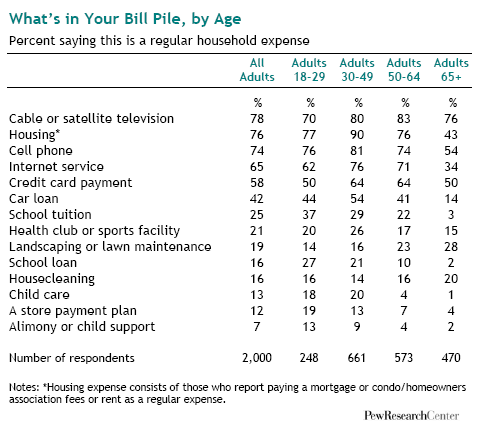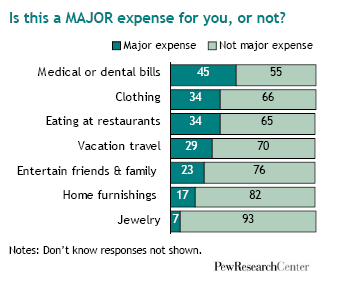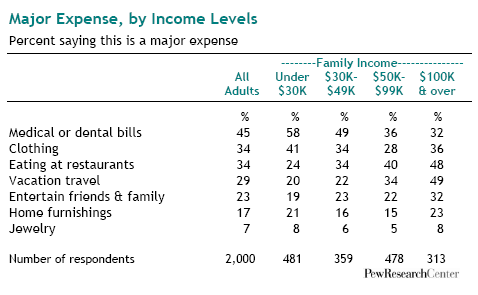Not surprisingly, housing is near the top of the public’s list of regular expenses. This is true both for the 68% of Americans who own their home and the 27% who rent. Among homeowners, about a third (32%) report that they have no mortgage, while two-thirds report that they pay at least one mortgage bill each month. Also, a fifth of all homeowners regularly pay some kind of maintenance fee to a condo or homeowner’s association. Among renters, virtually all (97%) include rent among their regular bills. Altogether, 76% of Americans have regular housing expenses from either mortgage, rent or a maintenance fee for a condo or homeowner’s association.
Among the list of 13 other common household expenses asked about in this survey, cable and satellite TV service was most frequently cited as a regular household expense (78%), followed by cell phones (74%) and internet service (65%). By contrast, just four-in-ten adults (42%) say they make a car payment and just one-in-four say they make a school tuition payment.

There’s a sharp age skew to who’s most likely to be paying regularly for “information age” services. Older adults (ages 65 and over) are less likely than both the young and middle-aged to have cell phones (54% compared with 74% among those ages 50 to 64) and internet services (34% compared with 71% among those ages 50 to 64) in their household bill pile.
The age variances extend to other expenses as well. As expected, the youngest group of adults (ages 18 to 29) are more likely than their elders to be paying for education; 37% of this group is paying for school tuition (for themselves or their children) compared with 29% among those ages 30 to 49 and 22% among those ages 50 to 64. Similarly, 27% of the younger age group is paying off a school loan, compared with 21% among those ages 30 to 49 and just 10% among those ages 50 to 64.
The list of regular expenses also varies by income levels. Those with family incomes of at least $100,000 are more likely than the less affluent to have regular expenses for a number of these items, including cell phones, internet services, lawn and landscaping service and housecleaning.
 Regardless of means, people think o
Regardless of means, people think o
f their expenses in different ways. When asked to consider which among a series of expenditures they considered to be a “major expense” for them, survey respondents most often cited health-related costs (45%), followed by clothing (34%) and restaurant dining (34%).
Not surprisingly, this line up of major expenses also varies by income. About half of those with family incomes of $100,000 and above consider vacation travel (49%) and dining out (48%) to be a major expense. Nearly six-in-ten (58%) of those with family incomes under $30,000 consider medical bills a major expense.

These assessments also vary somewhat by age and gender. Older women (ages 50 and older) are more likely than their male counterparts or than younger adults to classify medical expenses as a major expense. Younger women (those ages 18 to 49) are more inclined to consider clothing as a major household expense while younger men are more likely to say the same about eating out.


